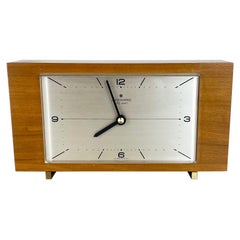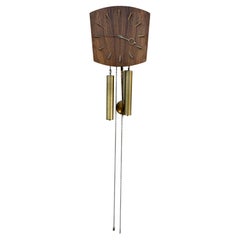Junghans Teak
Recent Sales
Wooden Teak Table Clock Max Bill Style Junghans Electronic, Germany, 1960s
By Max Bill, Junghans Uhren GmbH
Located in Kirchlengern, DE
Article:
Table clock
Origin:
Germany
Producer:
Junghans Electronic, Germany
Category
Late 20th Century German Mid-Century Modern Wall Clocks
Materials
Metal
H 4.61 in W 8.47 in D 2.56 in
Danish Mid Century Modern Teak And Brass Pendulum Wall Clock By Brixon
By Junghans Uhren GmbH
Located in San Carlos, CA
-Century Modern Design!
Introducing our stunning Danish mid-century modern vintage teak wall clock
Category
Vintage 1960s Danish Mid-Century Modern Wall Clocks
Materials
Brass
Vintage Junghans Pendulum Wall Clock in Teak from the 1960s
By Junghans Uhren GmbH
Located in Søborg, DK
Vintage Junghans pendulum wall clock from the 1960s In Teak with brass fittings.
In lovely working
Category
Vintage 1960s German Mid-Century Modern Wall Clocks
Materials
Brass
Vintage Junghans Pendulum Wall Clock in Teak from the 1960s
By Junghans Uhren GmbH
Located in Søborg, DK
Vintage Junghans pendulum wall clock from the 1960s in teak with brass fittings.
In lovely working
Category
Vintage 1960s German Mid-Century Modern Wall Clocks
Materials
Brass
Vintage German Junghans Pendulum Wall Clock in Teak and Brass
By Junghans Uhren GmbH
Located in Søborg, DK
Very handsome teak and brass pendulum wall clock made by Junghans of Germany in classic midcentury
Category
Vintage 1960s German Mid-Century Modern Wall Clocks
Materials
Brass
Vintage 1960s Hollywood Regency Teak Table Clock Junghans Electronic, Germany
By Junghans Uhren GmbH
Located in Kirchlengern, DE
Article:
Table clock
Origin:
Germany
Producer:
Junghans Electronic, Germany
Category
Late 20th Century German Mid-Century Modern Wall Clocks
Materials
Metal
H 4.93 in W 7.88 in D 2.17 in
Vintage Junghans Pendulum Wall Clock in Form Pressed Teak Veneer from the 1960s
By Junghans Uhren GmbH
Located in Søborg, DK
Vintage Junghans pendulum wall clock from the 1960s in form pressed teak veneer with brass fittings
Category
Vintage 1960s German Mid-Century Modern Wall Clocks
Materials
Brass
H 11.03 in W 11.03 in D 3.94 in
Elegant Mid-Century Junghans Meister Ato-Mat Teak and Brass Wall Clock, Germany
By Junghans Uhren GmbH
Located in Vienna, AT
An elegant and straight modernist wall clock with beautiful brass hands, a round teak wood housing
Category
Mid-20th Century German Mid-Century Modern Wall Clocks
Materials
Brass
H 11.5 in W 6.5 in D 2 in
Mid-Century Modern Wall Clock in Teak and Brass by Junghans, Germany
By Junghans Uhren GmbH
Located in Nürnberg, Bayern
The brass ring allows it to be suspended.
Made in Germany.
Electric, battery operated clock.
Category
Vintage 1960s German Mid-Century Modern Wall Clocks
Materials
Metal, Brass
Vintage Junghans Pendulum Wall Clock in Teak Veneer from the 1960s
By Junghans Uhren GmbH
Located in Søborg, DK
Vintage Junghans pendulum wall clock from the 1960s in teak veneer with brass fittings.
In lovely
Category
Vintage 1960s German Mid-Century Modern Wall Clocks
Materials
Brass
Vintage 1960s Modernist Wooden Teak Table Clock by Junghans Electronic, Germany
By Junghans Uhren GmbH
Located in Kirchlengern, DE
Article:
Table clock
Origin:
Germany
Producer:
Junghans Electronic, Germany
Category
Late 20th Century German Mid-Century Modern Wall Clocks
Materials
Metal
H 5.52 in W 9.06 in D 2.37 in
Junghans Table Clock "Exacta" Series in Teak and Brass with Alarm and Hour Chime
By Junghans Uhren GmbH
Located in Bridgeport, CT
This table clock is a wind up variety and makes a truly serene chime on the hour. It has a teak
Category
Vintage 1950s German Mid-Century Modern Table Clocks and Desk Clocks
Materials
Brass
H 7 in W 7 in D 3.5 in
Beautiful Mid-Century Junghans Ato-Mat Teak Wall Clock, Germany, 1950s
By Junghans Uhren GmbH, Max Bill
Located in Vienna, AT
A square modernist wall clock in the style of Max Bill, executed in the 1950s by Junghans Germany
Category
Mid-20th Century German Mid-Century Modern Wall Clocks
Materials
Glass, Wood, Teak
Danish Modern Mechanical Wall Clock
By Junghans Uhren GmbH
Located in Denton, TX
Germany by Junghans that is powered by the two brass weights and requires winding once a week. The clock
Category
Mid-20th Century European Mid-Century Modern Wall Clocks
Materials
Brass
Midcentury Junghans Starburst Teak Wall Clock
By Junghans Uhren GmbH
Located in Daylesford, Victoria
Midcentury German, Junghams wall clock, sunburst or star pattern in teak. Battery operated, all in
Category
Vintage 1960s German Mid-Century Modern Wall Clocks
Materials
Teak
Get Updated with New Arrivals
Save "Junghans Teak", and we’ll notify you when there are new listings in this category.
More Ways To Browse
Starburst Wall Clock
Mechanical Wall Clock
Wood Wall Clock 1960s
Junghans Ato
Danish Teak Clock
Junghans Ato Clocks
Junghans Meister Vintage
Repousse Clock
Seth Thomas Wall Clock
Starburst Wall Clock
Train Station Clock
Vintage 1930s Wall Clock
Vintage Schatz Clock
Vintage Smiths Electric Clock
Whimsical Clocks
Antique Clock 1920s
Art Deco Hexagon Clock
Chiming Wall Clock

